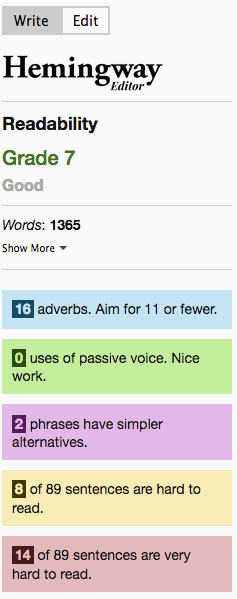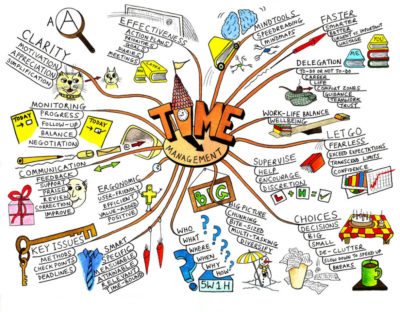There’s not a lot of gadgetry and technology that goes with writing. Sure, there are dozens of “simple” word processors out there, that all promise to strip out the unnecessary stuff from a word processing program, leaving you with the bare bones functionality.
But beyond that, there’s not a lot of apps that we writers can really benefit from. Not when we can pretty much function with a golf pencil and the back of an envelope to get our work done. Not like our illustrator and photographer friends, who have hundreds of apps to play with.
(However, I do have an affinity for the Hanx Writer app, developed by actor and noted typewriter collector, Tom Hanks to create typing sound effects on an iPhone or iPad.)
Still, there are a few apps that we writers can all use, regardless of what modern gadgets we use to create our work — laptop, tablet, or mobile phone, there’s some technology that we can all use to make our work better. Here are six of the ones that I recommend to new writers.

1. Hemingway App
If you want to tighten up your writing, I can’t recommend this enough. The Hemingway App looks for things like complicated sentences, unnecessarily big words (like “unnecessarily”), and even adverbs and passive voice. It grades your writing like the Flesch-Kincaid tool that Microsoft Word uses, to tell you if your writing is too complicated, and it helps find where you can simplify and improve your work.
While some people may worry that it might strip their writing of personality, I’ve always been of the “don’t describe a verb, use a descriptive verb” school. So if you’re just starting out and still fall into the adverb and adjective trap, this can help you get out of it.
2. Pomodoro Timer
I’m not a fan of those social media blocking apps that block all access to Facebook for several hours. I think it’s just a matter of exercising a little willpower. But I don’t have a problem. I’m not distracted. I could quit looking at social media any time I want. I just don’t want to. Leave me alone!
When it comes to increasing my productivity, I might need a little positive reinforcement instead. So I’ll set a countdown timer on my phone for 20 or 30 minutes, and work furiously on a project until the timer sounds. I know I can’t do anything else within that time until the timer ends. Turns out, there’s even a name for this. It’s called the Pomodoro Technique, which is Italian for “tomato.”
“Pomodoro” is, not “technique.”
In the Pomodoro Technique you set a timer for, say, 20 minutes, where you work furiously and then take a 3 – 5 minute break. Then you reset it and work for 20 minutes again. After three or four Pomodoros, you can take a longer break. It’s useful for any kind of productivity, but especially writers. There are apps available for both iOS and Android, although you can even buy little tomato shaped kitchen timers. (Check out the link for a few of the more popular versions.)
3. Todoist
Todoist is a to-do list manager that also works on all devices and operating systems. Save an item on your phone, it appears on your laptop. Mark it as completed on your tablet, and it marks it as completed on everywhere else.
You can create categories for specific projects or even publications. Save ideas, remind yourself to submit to writing contests, or use it to send yourself reminders about plot points. I use it for both my work and personal writing, and I’ve set recurring tasks for things I need to remember to do every day or week.
Todoist is also unique in that it adds some game elements to your accomplishments. Set a goal for daily accomplishments and then see how many days in a row you can get things done. Achieve certain levels of “enlightenment” accomplishment as you rack up more and more points as you get more stuff done. I like Todoist more than to do apps like Wunderlist or GTD, because of the competitive element, but you can shut it off if that part doesn’t appeal to you.
 4. MindMeister
4. MindMeister
Mind mapping is a great way to visually organize your ideas around a larger topic. You might draw a map about a speech, a short story, or even organizing a special event or a committee. And some of these can become quite colorful and gorgeous to look at.
Let’s say you’re organizing a party, and you have a few major areas, like Entertainment, Venue, and Food. Put PARTY in the middle of your screen and draw lines out to your categories around the center.
Rather than trying to organize all the details in a top-to-bottom list — Call a band; Rent a PA system; Get gluten-free hot dog buns — you create separate lists under each category, as you bounce between each category as ideas come to you. This helps you create a visual model of your thought process.
Now, imagine being able to do this with a novel, a story, an essay, a screenplay, and so on. By organizing everything with a mind map like MindMeister, you can be as jumbled and non-linear as you would like and still keep track of it all. MindMeister is a web-based product, but you can download it to your tablet or mobile phone too to create, organize, and save all of your big ideas.
5. Dropbox
While it’s normally a file sharing drop point, where you can share documents, photos, and videos, Dropbox is an excellent way to store your work in the cloud, safe from loss of your laptop. You can share individual folders with people, rather than giving them full access to your entire account, and give them varying levels of permission to make changes and edits.
Plus, it’s also accessible via your phone and tablet. You can even play videos and audio files right on Dropbox, so it’s a great place to store any video/audio notes you might have taken, and then play them right on your phone or tablet.
You can get a few gigabytes of free storage with your account, and then get a few more if you invite people to join. I currently pay $9.99 per month for 1 TB of storage, and I keep a lot of files stored there, which saves me a lot of space on my hard drive.
6. Evernote:
Alright, alright! I hate myself for even mentioning it! Every “top apps you must have” list always contains Evernote, and it just seems cheap to even include it. That’s why I made this a top six list, and not a top five. Because even though it’s about as predictable as you can possibly get, Evernote is still a top-notch program, and I would hate my own dislike for predictability to keep you from missing out on what may be the most important program on this list!
Evernote isn’t just a note taking app, it’s a note saving app. It’s an information organizing app. It’s a picture storing app. It’s a document scanning app. It’s even a “scan-a-business-card-import-their-LinkedIn-info-and-send-them-your-own-contact-info” app.
I use Evernote to create packing lists, store notes about my current novel in a folder, store future ideas for humor columns, keep articles about my day job work, and store pieces to read at one of the open mics around Orlando. I can save entire pages or articles from the web, take pictures of books I want to read, and as I mentioned earlier, even use it to scan someone’s business card, save it to my phone contacts, and send them my own information.
What are some of your favorite productivity apps? What do you use to help you get your work done? Leave a comment below and share your genius with the rest of us!
Photo credit: Jean-Louis Zimmerman (Flickr, Creative Commons 2.0)

Jade Kerrion
I’ve started using Microsoft One Note is lieu of Evernote (which now charges a fee if you want it on more than one device.)
Erik Deckers
Hi Jade,
I’ve heard of One Note, but I’ve been a pro user of Evernote (i.e. they suckered me into paying the fee) since 2009. And there’s so much more information and even a community of users around Evernote that I’d feel like I’d be giving up a lot more intangibles. Also, as an Apple user, there’s just something icky about using anything Microsoft. . . 😉
Erik
Karina Cadora
I use Wunderlist as my to-do list manager.
Erik Deckers
Hey Karina,
I used to use Wunderlist, but I could never quite get into the habit of using it, plus it didn’t seem to integrate into other things like Gmail (I think it can, I just didn’t know it). Once I discovered the competitive aspect of Todoist, I committed to learning how to use it, and now it’s a regular thing for me. I just broke a 149 day streak last week because I forgot to check off a few things on my birthday.
Erik
RTodd
I use grammarly. It’s a great way to knock out a lot of the kinks in your words. I tend cut/paste my work from Scrivener into a grammarly file, do the preliminary edits, then throw it into Hemingway app. Admittedly, it doesn’t catch everything (and even catches some things that are wrong), but it’s a nice combo.
Erik Deckers
Hey, RTodd!
I have a Grammarly plugin for Chrome (in fact, it just reminded me to put a comma after Hey in the salutation). I’ve considered using it myself, but I didn’t want to pay the monthly fee. However, that may change, since the plugin has shown me I sometimes use commas incorrectly, or at least a little too liberally.
I also use the paid desktop version of Hemingway App, so I can work offline at times.
Erik
Sandra Elliot
Hey Erik,
I love the ideas you shared and read through the first four app suggestions with great interest. I’ll give them a try. The last two, not. First of all, DropBox enabled a hacker posed as an Apple techie, yes, directly supposedly representing Apple via their internet system, to link my password-keeper 1Password, with my DropBox and link them to his iPhone, all this while talking to me (bet he’d probably done it before). I contacted DropBox to let them know, but that was just about the time they’d been hacked too and had nothing to say. I stay away from DropBox like the plaque.
About Evernote, I’ve tried and tried to use it. Love that it syncs computer with iPhone, but I’ve never found it helpful. To me, it’s too much like Scrivener. It takes a lot to organize it, and it’s just simpler to create and place files where I want them myself. I do like OneNote. It’s so much simpler.
I commend you for sharing your ideas and getting other writers to share thoughts—a very helpful way to become acquainted with what people are doing Writers Helping Writers!
Sandra Elliot